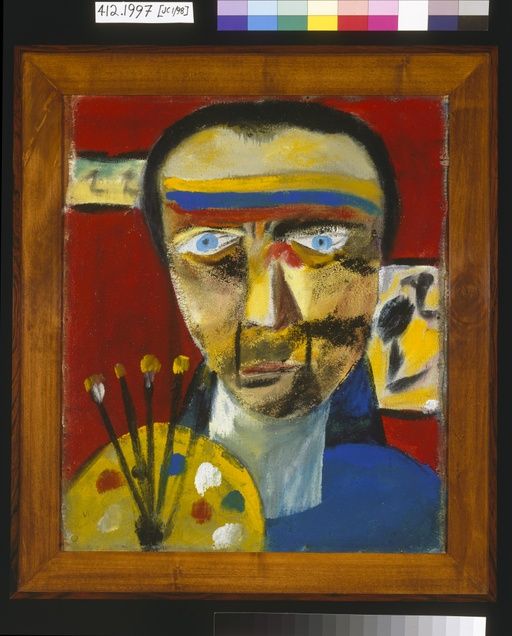

Self Portrait, 1943
Sidney Nolan, 1943, Ripolin enamel on hessian sacking, 61.0 x 52.0 cm stretcher; 72.0 x 62.8 x 4.5 cm frame, © The Trustees of the Sidney Nolan Trust
. Denise Mimmocchi is Senior Curator, Australian Art at the Art. Gallery of New South Wales
"In 1943, the young Nolan painted himself as an artist ready for combat. Confronting the viewer with a penetrating gaze, his brushes and palette are poised as his weaponry. He stands guarding his Wimmera pictures, products of the pictorial revelations with which he revolutionised his landscape painting. Their colours are infused on his skin; the paint of his palette is that of his warrior markings, as if the artist and his work are one and the same.
Nolan’s self-portrait was painted while on military duty. Stationed in the vast landscapes of the Wimmera plains safeguarding food stores from May 1942, the war may have appeared remote. But the Japanese bombing of Darwin earlier that year, and the lurking threat of active combat, made the peril real and present. The portrait projects this sense of menace but also signals another battleground that has the artist defending the terms of his modern creativity.
Nolan’s war-time service would ironically provide a platform for a period of intense experimentation and existential investigation. He not only developed his radical vision of the Australian environment from the Wimmera flatlands, but also first tested the expressive potential of Ripolin paint. Self portrait is telling of how he seized on the enamel’s flat, saturated finish to augment the power of his imagery.
Nolan would claim his later Ripolin-clad Kelly figure as a masked alter-ego. While the face of Nolan’s earlier self portrait is also mask-like, it exposes something of a raw and anxious emotional state beneath, while nonetheless determining a figure that is resolutely, and fiercely, avant-garde."